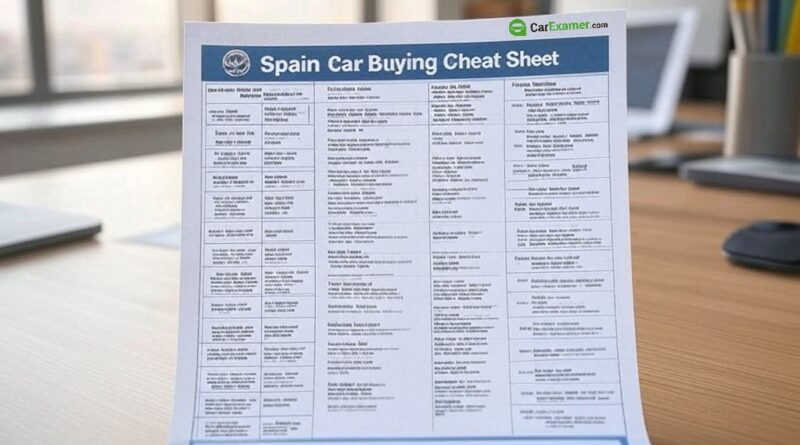Spain Car Buying Cheat Sheet: What You Really Need to Know
Thinking about buying a car in Spain? Whether you’re a local or just moved here, the used car market can be great — but also a bit confusing if you don’t know the rules. Here’s a simple, no-fluff cheat sheet to help you buy with confidence and avoid the usual headaches.
1. Locally Owned Cars (Spain-Registered from New)
The majority of used cars for sale in Spain are originally registered in Spain.
You’ll find:
- Lease returns (ex-rental or company fleet cars)
- Privately owned vehicles
- Dealer trade-ins
Pros: Clear local history, known ITV inspection trail
Cons: Sometimes high mileage from long-distance use (especially ex-rentals)
✅ 2. Imported Cars (Germany, France, Italy, Belgium)
Spain also imports a good number of used cars, especially:
- Germany – Most popular (well-maintained, good condition)
- France & Italy – Cheaper, but sometimes less reliable history
- Belgium / Netherlands – Often low-mileage, but higher prices
These imports usually come from:
- Leasing companies offloading stock
- Salvage auctions (especially from Germany & Italy)
- Dealer bulk buys for resale in Spain
Tip: Always check the DGT Informe de Vehículo or car history online like VIN history check to see if a car was imported and when.
🚨 Why It Matters
| Local Car | Imported Car |
|---|---|
| Known Spanish service history | May hide previous accident or rollback |
| Easier to transfer ownership | Sometimes more complex paperwork |
| More transparent emissions class | Import might not match Spanish emission standards |
✅ 1. Always Check the Car’s History (DGT Report)
Before you fall in love with any car, check its official report from Spain’s traffic authority (DGT). It’s called the “Informe de Vehículo”, and it tells you:
- How many owners the car’s had
- If it’s ever been written off or in an accident
- If there are unpaid debts or fines
- When the last inspection (ITV) was done
👉 You can get it online with the registration number or VIN.
If the seller won’t show it — walk away.
✅ 2. Know the Extra Costs
Buying a car here isn’t just about the price tag.
You’ll usually pay:
- 4–8% transfer tax, depending on the region
- A DGT transfer fee (around €55–€150)
- Maybe registration tax if you’re importing
Always ask what’s included in the price and what’s not — don’t get surprised later.
✅ 3. Don’t Skip a Test Drive or Inspection
Even if the car looks perfect, it might hide issues.
Take it for a test drive and check:
- How it drives and sounds
- If warning lights pop up
- Brakes, tyres, and electrics
💡 Want to be extra safe? Get an inspection from an independent garage or a mobile services.
✅ 4. Get the Paperwork Right
Spain is strict with car documents — and so should you be.
Make sure the seller gives you:
- The Permiso de Circulación (ownership doc)
- The Ficha Técnica (technical sheet)
- Proof of tax (IVTM)
- Their DNI/NIE to match the paperwork
⚠️ Never buy without seeing all the documents — no matter how nice the car looks.
✅ 5. Yes, You Can Negotiate
It’s totally fine to negotiate in Spain — just do it politely.
Use anything the car needs (like tyres or an oil change) to lower the price a bit.
A 5–10% discount is realistic in most cases.
🚨 Common Mistakes to Avoid
| Mistake | Why It’s a Problem |
|---|---|
| Not checking the DGT report | You could end up with a car that’s in debt |
| Ignoring the ITV date | Might need repairs or won’t pass inspection |
| No ownership transfer | You stay legally tied to the car |
| Paying cash with no receipt | No protection if something goes wrong |
🛠 Final Tip
Buying a car in Spain can be smooth — as long as you slow down, check the paperwork, and don’t rush into anything.
Whether you’re in Madrid, Málaga, or Marbella, this cheat sheet will help you spot red flags and buy with confidence.
Good luck — and enjoy the drive! 🚗🇪🇸
Buying a used VW. Buying used vauxhall, BMW, Jaguar, Ford, Volvo, Range rover, Bentley, Aston Martin, Porsche, Ferrari, Lamborghini, Maserati, Hyundai, Tesla, Honda, Pagani

